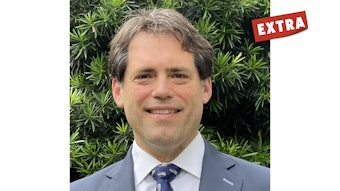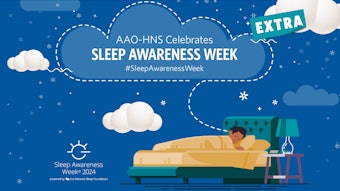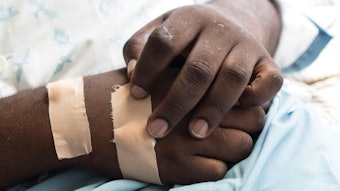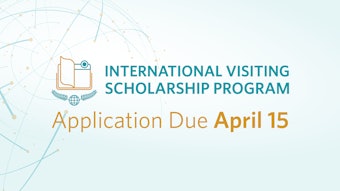Hearing Loss in Cancer Patients
Alongside advancements in otoprotective drug delivery and radiation techniques, it is imperative to recognize the extreme impact of hearing loss on the overall well-being of oncologic patients.
Samuel H. Smith, MD, David S. Lee, MD, and Celine Richard, MD, PhD, for the Hearing Committee

Addressing Hearing-Related Issues in Cancer Patients
As innovative cancer therapies continue to evolve, there has been a discernible increase in the survival rates of individuals afflicted with cancer, with an anticipated rise of nearly 25% in the population of cancer survivors within the coming decade.1 This progress has prompted a shift toward addressing both immediate and long-term complications and quality of life issues particularly around cancer treatments. Particularly relevant to the otolaryngologist is the onset of hearing impairment, which, while not immediately life-threatening, can profoundly impact quality of life across all age groups.
In children, even subtle high-frequency hearing loss can lead to delays in speech and language acquisition2 and pose challenges that accrue over time, resulting in academic underachievement and diminished quality of life compared to peers with normal hearing.3 In adults, hearing loss may precipitate social isolation and depression, particularly within a patient population already at high risk of psychosocial distress.4,5 The ototoxic effects of cancer treatment have enduring implications, adversely affecting communication, work capacity, mental well-being, and various other factors that influence quality of life during survivorship.
Hearing impairment related to cancer treatment can arise from multiple modalities, including surgical or radiation treatment to the head and neck or systemic chemotherapy. In combination, these treatments may lead to synergistic auditory dysfunction. Given the escalating concern surrounding treatment-related ototoxicity, understanding and addressing hearing-related issues in cancer patients is imperative for delivering holistic care throughout the continuum of survivorship. In this article, we discuss hearing loss resulting from platinum-based chemoradiation therapy and recent advancements in ototoxicity treatment and prevention, laying the groundwork for future research.
Chemotherapy-Induced Hearing Loss
Sensorineural hearing loss (SNHL) secondary to chemotherapy has been well established with multiple individual drug and drug combinations, the most potent being the platinum based agents.6 Platinum compounds cisplatin, carboplatin, and oxaliplatin are used to treat both solid and hematologic malignancies where they act to interrupt DNA transcription, leading to cell death. Cisplatin, a frequent agent in chemotherapy protocols and most often administered as a multidose, multicycle protocol,7 exhibits enhanced antineoplastic properties owing to its unique stereochemical structure. But the drug also displays heightened ototoxicity, leading to SNHL. Different mechanisms, which include DNA crosslinking, cell cycle disruption,8 defective mitochondrial function,9,10 generation of STve nitrogen or oxygen compounds,11,12 and stimulation of proinflammatory cytokines pathways related to involving ERK and NF-kb,13,14 are involved in cisplatin-induced ototoxicity. When entering cells, cisplatin undergoes physicochemical changes due to the lower intracellular chloride concentration, preventing its exit from the cytoplasm.15–19 This accumulation leads to subsequent damage to inner ear structures, particularly to the outer hair cells, spiral ganglion cells, and stria vascularis (Figure 1),20,21 in a dose-dependent manner.22 This accumulation disrupts the function of the stria vascularis, causing an imbalance in endolymphatic fluid and compromising the function and survival of hair cells.23,24 The cochlear ototoxicity induced by cisplatin displays an apicobasal gradient, with the outer hair cells at the basal turn being most vulnerable.22,23,25
Clinically, cisplatin-induced hearing loss typically presents as an irreversible,26–28 bilateral high-frequency SNHL, often accompanied by tinnitus. Onset occurs within hours to days following administration, with progression over several years.23,29,30 Patient and treatment factors, such as age (<5 years),31,32 higher dose,33 treatment duration, nutritional status, administration method, number of cycles, renal insufficiency, and concurrent radiation therapy,34–37 contribute to increased prevalence of ototoxicity. Sensitivity to platinum-based drugs also differs among individuals38,39 with genetic variations in metabolic enzymes such as thiopurine methyltransferase and catechol O-methyltransferase.40,41 Thus, recommendations for pre-treatment pharmacogenetic testing have been developed to identify individuals at high risk for ototoxicity.42 Notably, any agent that disrupts cochlear blood flow (e.g., loop diuretics43–46) or enhances cisplatin influx to the cochlea (e.g., ethacrynic acid),47 or influences endolymphatic homeostasis or neural conduction, may intensify cisplatin-induced ototoxicity.
Prevention and Therapeutic Options to Counterbalance Chemotherapy Effects
Although the precise mechanisms underlying ototoxicity are incompletely understood, multiple mitigating agents are under evaluation. Four agents are of primary interest in preventing cisplatin-induced SNHL: sodium thiosulfate (STS),48,49 N-acetyl cysteine (NAC),50,51 alpha lipoic acid (ALA),52,53 and D-methionine.48,54 Administration of these agents has been trialed in systemic and direct application.55 STS and NAC act as neuroprotectants by preventing cisplatin binding to cellular components. However, STS can also bind cisplatin, thus decreasing therapeutic effect. Carefully scheduled drug administration in select patients may reduce ototoxicity in children where the effect in adults is less certain.56 Transtympanic NAC has been proposed to preserve hearing at the 8 kHz frequency,16 while the preventive effect of transtympanic STS gel application remains under consideration.57 ALA serves as a vital mitochondrial cofactor for antioxidant enzyme functions,58,59 exhibiting a protective effect against cisplatin-induced cochlear hair cell damage, albeit altering stereocilia shape. Its mechanism involves downregulating various proinflammatory pathways.25 In vitro and murine models have demonstrated that ALA protects mitochondrial function by preventing reactive oxygen species accumulation, prompting the need for clinical trials.60
Several more commonly used medications have also been investigated as mitigating agents. Widely available dexamethasone, known for its anti-inflammatory, antioxidant, and apoptotic effects, has demonstrated positive outcomes in clinical trials without compromising the efficacy of cisplatin.61 Statins have also gained attention as promising candidates. Lovastatin, in particular, has shown efficacy in mitigating cisplatin-induced hearing loss among adults receiving cisplatin therapy for head and neck cancer.55,62
Radiation-Induced Hearing Loss
Although chemotherapy-induced hearing loss is primarily sensorineural, ototoxicity from head and neck radiation may manifest as sensorineural, conductive, or mixed hearing loss. Radiation therapy (RT) plays an integral role in the management of head and neck cancer and neuro-oncological tumors, but it often involves the temporal bone and brainstem within the treatment area. This can lead to significant radiation exposure and can affect hearing at any level of the auditory pathway. While radiation-related hearing loss is widely acknowledged, comprehensive characterization remains limited.63 This is particularly true in regard to the interplay between radiation and its treatment counterparts, platinum-based chemotherapy agents.
Radiation-related SNHL is characterized as a late, progressive, generally permanent side effect of treatment. Although radiation can affect different levels of the auditory pathway, damage to the middle and inner ear prevails.
Radiation can affect the skin of the external ear and ear canal leading to erythema and desquamation (Figure 1), potentially resulting in pain and otorrhea and increasing the risk of local infections. In the early stages, the middle ear is similarly affected by disturbances in vascular flow, ciliary dysfunction, and mucinous gland loss, which heighten susceptibility to otitis media and conductive hearing loss.64,65 In later stages, fibrosis of the middle ear mucosa and eustachian tube musculature can lead to middle ear dysfunction lasting years after treatment.66 Further late complications include occasional structural damage, such as tympanic membrane perforation, and the risk of ossicular necrosis and temporal bone necrosis in adults (Figure 1).67
Recent findings indicate that children are more vulnerable to hearing impairment compared with adults, with a clear correlation between cochlear radiation dose and the risk of hearing impairment.68 Elevated cochlear radiation doses heighten the likelihood of such complications. However, data regarding pediatric support for the 30 to 35 Gy cochlear limit69,70 and the interplay between RT and cisplatin in hearing loss are scarce. There is ongoing uncertainty about which RT dose measurement—such as mean, median, minimum, or maximum—best predicts hearing loss, especially in non-tumor areas like the cochlea, where RT doses can vary widely.
Several mechanisms have been proposed based on the observed characteristics of radiation-induced SNHL. Ionizing radiation exerts an effect by causing damage to the DNA through direct and indirect mechanisms following the creation of free radicals from water molecules, disrupting normal intracellular homeostasis.71 Multiple subsites, including the cochlear duct, basilar membrane, spiral ligament, and stria vascularis, show cell loss in histopathologic evaluations, possibly via p53-independent pathways involving vascular endothelial damage.72
Advances in imaging, pre-treatment planning, and radiation modalities have led to improved outcomes for hearing in adults and children. In the effort to improve precision in targeting radiation to tumors while sparing healthy surrounding tissues, indication for and availability of proton radiotherapy (PRT) have significantly expanded, particularly in childhood cancer treatment. Its effectiveness in managing pediatric brain tumors, head and neck cancers, and adult skull base malignancies has been a driving force behind this growth. PRT has shown promising results with acceptable levels of toxicity, thanks to its ability to deliver lower doses to normal tissues, potentially minimizing both short-term and long-term treatment-related side effects.73–75 Improvements to existing radiation delivery mechanisms have also been developed. Intensity-modulated radiation therapy and volumetric-modulated arc therapy plans, for instance, can produce highly precise dose distributions that lead to decreased toxicity, and decreased treatment durations.76,77 These advancements in radiation technology have paved the way for the emergence of intensity-modulated PRT for patients with head and neck cancers. Early findings indicate promising outcomes in terms of reducing treatment-related toxicity and potentially increasing dose levels while adhering to tissue dose constraints.78
Hearing Rehabilitation
Hearing loss can create additional challenges for patients during their cancer journey, regardless of age. In children, it affects their communication abilities and social engagements, impacting neurocognitive development, educational progress, and overall well-being.79 For adults and seniors, it can lead to psychological distress,80 social isolation, diminished quality of life81 and accelerated cognitive decline,82 raising the risk of dementia.83 Evidence suggests that hearing rehabilitation can mitigate most of these challenges and reduce cognitive decline in high-risk individuals.84
The treatment of the primary tumor should not delay the provision of hearing aids. Close monitoring of hearing is necessary for any oncologic patients exposed to potentially ototoxic therapies. A multidisciplinary approach involving oncologists, radiation therapists, audiologists, and otolaryngologists will facilitate early rehabilitation with tailored solutions for each patient. This could include various options such as conventional hearing aids, CROS, bi-CROS, bone-conduction devices, including osseointegrated solutions, or non-surgical alternatives like soft bands, metal headbands, eyeglasses, or adhesives when suitable. For individuals experiencing severe to profound hearing loss and seeing minimal improvement with traditional hearing aids, recent reports indicate the benefits of cochlear implantation in the oncology patient population, with emerging indications for electric-acoustic stimulation.85
 Figure 1. Diagram of the key mechanisms responsible for hearing loss in the oncologic population. The close-up image illustrates the primary impact of cisplatin on the inner ear.
Figure 1. Diagram of the key mechanisms responsible for hearing loss in the oncologic population. The close-up image illustrates the primary impact of cisplatin on the inner ear.
Abbreviations: inner sulcus cell (ISC), inner border cell (IBC), inner hair cell (IHC), tectorial membrane (TM), outer hair cell (OHC), Hensen’s cell (HC), Claudius’ cell (CC), basilar membrane (BM), Boettcher’s cell (BC), Deiters’ cell (i.e., outer phalangeal cell) (DC), outer pillar cell (OPC), inner pillar cell (IPC), inner phalangeal cell (IphC), piral ganglion neuron in the spiral canal of Rosenthal (SGN).
References
- American Cancer Society. Cancer Treatment & Survivorship Facts & Figures 2022-2024. 2022. https://www.cancer.org/content/dam/cancer-org/research/cancer-facts-and-statistics/cancer-treatment-and-survivorship-facts-and-figures/2022-cancer-treatment-and-survivorship-fandf-acs.pdf.
- Tomblin JB, Harrison M, Ambrose SE, Walker EA, Oleson JJ, Moeller MP. Language Outcomes in Young Children with Mild to Severe Hearing Loss. Ear Hear. 2015;36(0 1):76S-91S. doi:10.1097/AUD.0000000000000219
- Roland L, Fischer C, Tran K, Rachakonda T, Kallogjeri D, Lieu JEC. Quality of Life in Children with Hearing Impairment: Systematic Review and Meta-analysis. Otolaryngol--Head Neck Surg Off J Am Acad Otolaryngol-Head Neck Surg. 2016;155(2):208-219. doi:10.1177/0194599816640485
- Ciorba A, Bianchini C, Pelucchi S, Pastore A. The impact of hearing loss on the quality of life of elderly adults. Clin Interv Aging. 2012;7:159-163. doi:10.2147/CIA.S26059
- Buchmann L, Conlee J, Hunt J, Agarwal J, White S. Psychosocial distress is prevalent in head and neck cancer patients. The Laryngoscope. 2013;123(6):1424-1429. doi:10.1002/lary.23886
- Hirose Y, Simon JA, Ou HC. Hair cell toxicity in anti-cancer drugs: evaluating an anti-cancer drug library for independent and synergistic toxic effects on hair cells using the zebrafish lateral line. J Assoc Res Otolaryngol JARO. 2011;12(6):719-728. doi:10.1007/s10162-011-0278-z
- Langer T, am Zehnhoff-Dinnesen A, Radtke S, Meitert J, Zolk O. Understanding platinum-induced ototoxicity. Trends Pharmacol Sci. 2013;34(8):458-469. doi:10.1016/j.tips.2013.05.006
- Jamieson ER, Lippard SJ. Structure, Recognition, and Processing of Cisplatin-DNA Adducts. Chem Rev. 1999;99(9):2467-2498. doi:10.1021/cr980421n
- Sugiyama S, Hayakawa M, Kato T, Hanaki Y, Shimizu K, Ozawa T. Adverse effects of anti-tumor drug, cisplatin, on rat kidney mitochondria: disturbances in glutathione peroxidase activity. Biochem Biophys Res Commun. 1989;159(3):1121-1127. doi:10.1016/0006-291x(89)92225-0
- Lee DS, Schrader A, Warchol M, Sheets L. Cisplatin exposure acutely disrupts mitochondrial bioenergetics in the zebrafish lateral-line organ. Hear Res. 2022;426:108513. doi:10.1016/j.heares.2022.108513
- Watanabe KI, Hess A, Bloch W, Michel O. Nitric oxide synthase inhibitor suppresses the ototoxic side effect of cisplatin in guinea pigs. Anticancer Drugs. 2000;11(5):401-406. doi:10.1097/00001813-200006000-00011
- Matsushima H, Yonemura K, Ohishi K, Hishida A. The role of oxygen free radicals in cisplatin-induced acute renal failure in rats. J Lab Clin Med. 1998;131(6):518-526. doi:10.1016/s0022-2143(98)90060-9
- So H, Kim H, Lee JH, et al. Cisplatin cytotoxicity of auditory cells requires secretions of proinflammatory cytokines via activation of ERK and NF-kappaB. J Assoc Res Otolaryngol JARO. 2007;8(3):338-355. doi:10.1007/s10162-007-0084-9
- Previati M, Lanzoni I, Astolfi L, et al. Cisplatin cytotoxicity in organ of corti‐derived immortalized cells. J Cell Biochem. Published online 2007. doi:10.1002/jcb.21239
- Knight KR, Chen L, Freyer D, et al. Group-Wide, Prospective Study of Ototoxicity Assessment in Children Receiving Cisplatin Chemotherapy (ACCL05C1): A Report From the Children’s Oncology Group. J Clin Oncol. 2017;35(4):440-445. doi:10.1200/JCO.2016.69.2319
- Mukherjea D, Dhukhwa A, Sapra A, et al. Strategies to reduce the risk of platinum containing antineoplastic drug-induced ototoxicity. Expert Opin Drug Metab Toxicol. 2020;16(10):965-982. doi:10.1080/17425255.2020.1806235
- Knight KRG, Kraemer DF, Neuwelt EA. Ototoxicity in children receiving platinum chemotherapy: underestimating a commonly occurring toxicity that may influence academic and social development. J Clin Oncol Off J Am Soc Clin Oncol. 2005;23(34):8588-8596. doi:10.1200/JCO.2004.00.5355
- Kushner BH, Budnick A, Kramer K, Modak S, Cheung NKV. Ototoxicity from high-dose use of platinum compounds in patients with neuroblastoma. Cancer. 2006;107(2):417-422. doi:10.1002/cncr.22004
- Shi X. Pathophysiology of the cochlear intrastrial fluid-blood barrier (review). Hear Res. 2016;338:52-63. doi:10.1016/j.heares.2016.01.010
- van Ruijven MWM, de Groot JCMJ, Klis SFL, Smoorenburg GF. The cochlear targets of cisplatin: an electrophysiological and morphological time-sequence study. Hear Res. 2005;205(1-2):241-248. doi:10.1016/j.heares.2005.03.023
- Kohn S, Fradis M, Pratt H, et al. Cisplatin ototoxicity in guinea pigs with special reference to toxic effects in the stria vascularis. The Laryngoscope. 1988;98(8 Pt 1):865-871. doi:10.1288/00005537-198808000-00015
- Fernandez K, Wafa T, Fitzgerald TS, Cunningham LL. An optimized, clinically relevant mouse model of cisplatin-induced ototoxicity. Hear Res. 2019;375:66-74. doi:10.1016/j.heares.2019.02.006
- Breglio AM, Rusheen AE, Shide ED, et al. Cisplatin is retained in the cochlea indefinitely following chemotherapy. Nat Commun. 2017;8(1):1654. doi:10.1038/s41467-017-01837-1
- Liu H, Li Y, Chen L, et al. Organ of Corti and Stria Vascularis: Is there an Interdependence for Survival? PLOS ONE. 2016;11(12):e0168953. doi:10.1371/journal.pone.0168953
- Kim J, Cho HJ, Sagong B, et al. Alpha-lipoic acid protects against cisplatin-induced ototoxicity via the regulation of MAPKs and proinflammatory cytokines. Biochem Biophys Res Commun. 2014;449(2):183-189. doi:10.1016/j.bbrc.2014.04.118
- Bass JK, Liu W, Banerjee P, et al. Association of Hearing Impairment With Neurocognition in Survivors of Childhood Cancer. JAMA Oncol. 2020;6(9):1363-1371. doi:10.1001/jamaoncol.2020.2822
- McHaney VA, Thibadoux G, Hayes FA, Green AA. Hearing loss in children receiving cisplatin chemotherapy. J Pediatr. 1983;102(2):314-317. doi:10.1016/s0022-3476(83)80551-4
- Schell MJ, McHaney VA, Green AA, et al. Hearing loss in children and young adults receiving cisplatin with or without prior cranial irradiation. J Clin Oncol Off J Am Soc Clin Oncol. 1989;7(6):754-760. doi:10.1200/JCO.1989.7.6.754
- Sheth S, Mukherjea D, Rybak LP, Ramkumar V. Mechanisms of Cisplatin-Induced Ototoxicity and Otoprotection. Front Cell Neurosci. 2017;11:338. doi:10.3389/fncel.2017.00338
- Dutton, S.C., Neault, M., Billett, A.E., LaVally, B., Scott, R.M., Sallan, S.E., & Tarbell, N.J. (1996). Progressive ototoxicity after combined modality treatment of medulloblastoma. International Journal of Radiation Oncology, Biology and Physics, 36(1,suppl1), 167.
- Li Y, Womer RB, Silber JH. Predicting cisplatin ototoxicity in children: the influence of age and the cumulative dose. Eur J Cancer Oxf Engl 1990. 2004;40(16):2445-2451. doi:10.1016/j.ejca.2003.08.009
- Yancey A, Harris MS, Egbelakin A, Gilbert J, Pisoni DB, Renbarger J. Risk factors for cisplatin-associated ototoxicity in pediatric oncology patients. Pediatr Blood Cancer. 2012;59(1):144-148. doi:10.1002/pbc.24138
- Blakley BW, Gupta AK, Myers SF, Schwan S. Risk factors for ototoxicity due to cisplatin. Arch Otolaryngol Head Neck Surg. 1994;120(5):541-546. doi:10.1001/archotol.1994.01880290051009
- Dilruba S, Kalayda GV. Platinum-based drugs: past, present and future. Cancer Chemother Pharmacol. 2016;77(6):1103-1124. doi:10.1007/s00280-016-2976-z
- P Farrell N. Platinum formulations as anticancer drugs clinical and pre-clinical studies. Curr Top Med Chem. 2011;11(21):2623-2631. doi:10.2174/156802611798040714
- Gormley PE, Bull JM, LeRoy AF, Cysyk R. Kinetics of cis-dichlorodiammineplatinum. Clin Pharmacol Ther. 1979;25(3):351-357. doi:10.1002/cpt1979253351
- Pan CC, Eisbruch A, Lee JS, Snorrason RM, Ten Haken RK, Kileny PR. Prospective study of inner ear radiation dose and hearing loss in head-and-neck cancer patients. Int J Radiat Oncol Biol Phys. 2005;61(5):1393-1402. doi:10.1016/j.ijrobp.2004.08.019
- Tserga E, Nandwani T, Edvall NK, et al. The genetic vulnerability to cisplatin ototoxicity: a systematic review. Sci Rep. 2019;9(1):3455. doi:10.1038/s41598-019-40138-z
- Peters U, Preisler-Adams S, Lanvers-Kaminsky C, Jürgens H, Lamprecht-Dinnesen A. Sequence variations of mitochondrial DNA and individual sensitivity to the ototoxic effect of cisplatin. Anticancer Res. 2003;23(2B):1249-1255.
- Du X, Schwander M, Moresco EMY, et al. A catechol-O-methyltransferase that is essential for auditory function in mice and humans. Proc Natl Acad Sci U S A. 2008;105(38):14609-14614. doi:10.1073/pnas.0807219105
- Hagleitner MM, Coenen MJH, Patino-Garcia A, et al. Influence of Genetic Variants in TPMT and COMT Associated with Cisplatin Induced Hearing Loss in Patients with Cancer: Two New Cohorts and a Meta-Analysis Reveal Significant Heterogeneity between Cohorts. PLOS ONE. 2014;9(12):e115869. doi:10.1371/journal.pone.0115869
- Lee JW, Pussegoda K, Rassekh SR, et al. Clinical Practice Recommendations for the Management and Prevention of Cisplatin-Induced Hearing Loss Using Pharmacogenetic Markers. Ther Drug Monit. 2016;38(4):423-431. doi:10.1097/FTD.0000000000000298
- Clemens E, de Vries AC, Pluijm SF, et al. Determinants of ototoxicity in 451 platinum-treated Dutch survivors of childhood cancer: A DCOG late-effects study. Eur J Cancer Oxf Engl 1990. 2016;69:77-85. doi:10.1016/j.ejca.2016.09.023
- Patschan D, Patschan S, Buschmann I, Ritter O. Loop Diuretics in Acute Kidney Injury Prevention, Therapy, and Risk Stratification. Kidney Blood Press Res. 2019;44(4):457-464. doi:10.1159/000501315
- Santoso JT, Lucci JA, Coleman RL, Schafer I, Hannigan EV. Saline, mannitol, and furosemide hydration in acute cisplatin nephrotoxicity: a randomized trial. Cancer Chemother Pharmacol. 2003;52(1):13-18. doi:10.1007/s00280-003-0620-1
- Forge A, Brown AM. Ultrastructural and electrophysiological studies of acute ototoxic effects of furosemide. Br J Audiol. 1982;16(2):109-116. doi:10.3109/03005368209081455
- Clerici WJ, Hensley K, DiMartino DL, Butterfield DA. Direct detection of ototoxicant-induced reactive oxygen species generation in cochlear explants. Hear Res. 1996;98(1-2):116-124. doi:10.1016/0378-5955(96)00075-5
- Giordano P, Lorito G, Ciorba A, Martini A, Hatzopoulos S. Protection against cisplatin ototoxicity in a Sprague-Dawley rat animal model. Acta Otorhinolaryngol Ital. 2006;26(4):198-207.
- Freyer DR, Chen L, Krailo MD, et al. Effects of sodium thiosulfate versus observation on development of cisplatin-induced hearing loss in children with cancer (ACCL0431): a multicentre, randomised, controlled, open-label, phase 3 trial. Lancet Oncol. 2017;18(1):63-74. doi:10.1016/S1470-2045(16)30625-8
- Low WK, Sun L, Tan MGK, Chua AWC, Wang DY. L-N-Acetylcysteine protects against radiation-induced apoptosis in a cochlear cell line. Acta Otolaryngol (Stockh). 2008;128(4):440-445. doi:10.1080/00016480701762490
- Kim SJ, Jeong HJ, Myung NY, et al. The protective mechanism of antioxidants in cadmium-induced ototoxicity in vitro and in vivo. Environ Health Perspect. 2008;116(7):854-862. doi:10.1289/ehp.10467
- Wenzel U, Nickel A, Daniel H. alpha-Lipoic acid induces apoptosis in human colon cancer cells by increasing mitochondrial respiration with a concomitant O2-*-generation. Apoptosis Int J Program Cell Death. 2005;10(2):359-368. doi:10.1007/s10495-005-0810-x
- Lin YC, Lai YS, Chou TC. The Protective Effect of Alpha-Lipoic Acid in Lipopolysaccharide-Induced Acute Lung Injury Is Mediated by Heme Oxygenase-1. Evid Based Complement Alternat Med. 2013;2013:e590363. doi:10.1155/2013/590363
- Campbell KCM, Meech RP, Rybak LP, Hughes LF. The effect of D-methionine on cochlear oxidative state with and without cisplatin administration: mechanisms of otoprotection. J Am Acad Audiol. 2003;14(3):144-156.
- Chattaraj A, Syed MP, Low CA, Owonikoko TK. Cisplatin-Induced Ototoxicity: A Concise Review of the Burden, Prevention, and Interception Strategies. JCO Oncol Pract. 2023;19(5):278-283. doi:10.1200/OP.22.00710
- Chen CH, Huang CY, Lin HYH, Wang MC, Chang CY, Cheng YF. Association of Sodium Thiosulfate With Risk of Ototoxic Effects From Platinum-Based Chemotherapy: A Systematic Review and Meta-analysis. JAMA Netw Open. 2021;4(8):e2118895. doi:10.1001/jamanetworkopen.2021.18895
- Duinkerken CW, de Weger VA, Dreschler WA, et al. Transtympanic Sodium Thiosulfate for Prevention of Cisplatin-Induced Ototoxicity: A Randomized Clinical Trial. Otol Neurotol Off Publ Am Otol Soc Am Neurotol Soc Eur Acad Otol Neurotol. 2021;42(5):678-685. doi:10.1097/MAO.0000000000003069
- Haramaki N, Han D, Handelman GJ, Tritschler HJ, Packer L. Cytosolic and mitochondrial systems for NADH- and NADPH-dependent reduction of alpha-lipoic acid. Free Radic Biol Med. 1997;22(3):535-542. doi:10.1016/s0891-5849(96)00400-5
- Packer L, Witt EH, Tritschler HJ. alpha-Lipoic acid as a biological antioxidant. Free Radic Biol Med. 1995;19(2):227-250. doi:10.1016/0891-5849(95)00017-r
- Kim KH, Lee B, Kim YR, et al. Evaluating protective and therapeutic effects of alpha-lipoic acid on cisplatin-induced ototoxicity. Cell Death Dis. 2018;9(8):827. doi:10.1038/s41419-018-0888-z
- Marshak T, Steiner M, Kaminer M, Levy L, Shupak A. Prevention of Cisplatin-Induced Hearing Loss by Intratympanic Dexamethasone: A Randomized Controlled Study. Otolaryngol--Head Neck Surg Off J Am Acad Otolaryngol-Head Neck Surg. 2014;150(6):983-990. doi:10.1177/0194599814524894
- Fernandez KA, Allen P, Campbell M, et al. Atorvastatin is associated with reduced cisplatin-induced hearing loss. J Clin Invest. 2021;131(1):e142616, 142616. doi:10.1172/JCI142616
- Murphy B, Jackson A, Bass JK, et al. Modeling the Risk of Hearing Loss From Radiation Therapy in Childhood Cancer Survivors: A PENTEC Comprehensive Review. Int J Radiat Oncol Biol Phys. Published online October 19, 2023:S0360-3016(23)07779-9. doi:10.1016/j.ijrobp.2023.08.016
- Hoistad DL, Ondrey FG, Mutlu C, Schachern PA, Paparella MM, Adams GL. Histopathology of human temporal bone after cis-platinum, radiation, or both. Otolaryngol--Head Neck Surg Off J Am Acad Otolaryngol-Head Neck Surg. 1998;118(6):825-832. doi:10.1016/S0194-5998(98)70276-1
- Elwany S. Delayed ultrastructural radiation induced changes in the human mesotympanic middle ear mucosa. J Laryngol Otol. 1985;99(4):343-353. doi:10.1017/s002221510009681x
- Nader ME, Gidley PW. Challenges of Hearing Rehabilitation after Radiation and Chemotherapy. J Neurol Surg Part B Skull Base. 2019;80(2):214-224. doi:10.1055/s-0039-1677865
- Gyorkey J, Pollock FJ. Radiation necrosis of the ossicles. AMA Arch Otolaryngol. 1960;71:793-796. doi:10.1001/archotol.1960.03770050053008
- Huang Y, Zhou H, An F, et al. The relevance of ototoxicity induced by radiotherapy. Radiat Oncol. 2023;18(1):95. doi:10.1186/s13014-023-02268-7
- Paulino AC, Lobo M, Teh BS, et al. Ototoxicity after intensity-modulated radiation therapy and cisplatin-based chemotherapy in children with medulloblastoma. Int J Radiat Oncol Biol Phys. 2010;78(5):1445-1450. doi:10.1016/j.ijrobp.2009.09.031
- Scoccianti S, Detti B, Gadda D, et al. Organs at risk in the brain and their dose-constraints in adults and in children: a radiation oncologist’s guide for delineation in everyday practice. Radiother Oncol J Eur Soc Ther Radiol Oncol. 2015;114(2):230-238. doi:10.1016/j.radonc.2015.01.016
- Gao Y, Wu F, He W, Cai Z, Pang J, Zheng Y. Reactive Oxygen Species–Related Disruptions to Cochlear Hair Cell and Stria Vascularis Consequently Leading to Radiation-Induced Sensorineural Hearing Loss. Antioxid Redox Signal. Published online July 21, 2023. doi:10.1089/ars.2022.0161
- Mujica-Mota MA, Lehnert S, Devic S, Gasbarrino K, Daniel SJ. Mechanisms of radiation-induced sensorineural hearing loss and radioprotection. Hear Res. 2014;312:60-68. doi:10.1016/j.heares.2014.03.003
- Merchant TE. Clinical controversies: proton therapy for pediatric tumors. Semin Radiat Oncol. 2013;23(2):97-108. doi:10.1016/j.semradonc.2012.11.008
- Gaito S, Hwang EJ, France A, et al. Outcomes of Patients Treated in the UK Proton Overseas Programme: Central Nervous System Group. Clin Oncol R Coll Radiol G B. 2023;35(5):283-291. doi:10.1016/j.clon.2023.01.024
- Fortin D, Tsang D, Ng A, Laperriere N, Hodgson DC. Monte Carlo-driven predictions of neurocognitive and hearing impairments following proton and photon radiotherapy for pediatric brain-tumor patients. J Neurooncol. 2017;135(3):521-528. doi:10.1007/s11060-017-2597-3
- Verbakel WFAR, Cuijpers JP, Hoffmans D, Bieker M, Slotman BJ, Senan S. Volumetric intensity-modulated arc therapy vs. conventional IMRT in head-and-neck cancer: a comparative planning and dosimetric study. Int J Radiat Oncol Biol Phys. 2009;74(1):252-259. doi:10.1016/j.ijrobp.2008.12.033
- Wang X, Eisbruch A. IMRT for head and neck cancer: reducing xerostomia and dysphagia. J Radiat Res (Tokyo). 2016;57 Suppl 1(Suppl 1):i69-i75. doi:10.1093/jrr/rrw047
- Moreno AC, Frank SJ, Garden AS, et al. Intensity modulated proton therapy (IMPT) - The future of IMRT for head and neck cancer. Oral Oncol. 2019;88:66-74. doi:10.1016/j.oraloncology.2018.11.015
- Lieu JEC, Kenna M, Anne S, Davidson L. Hearing Loss in Children: A Review. JAMA. 2020;324(21):2195-2205. doi:10.1001/jama.2020.17647
- Niazi Y, Ejaz B, Muazzam A. Impact of hearing impairment on psychological distress and subjective well-being in older adults. Pak J Med Sci. 2020;36(6):1210-1215. doi:10.12669/pjms.36.6.2457
- Cheema K, Awan N, Raza N, Khan K, Qamar S, Ashraf S. Association of Comorbid Conditions with Six-month Survival and Disease Outcome in Patients of Necroinflammatory Otitis Externa. J Coll Physicians Surg--Pak JCPSP. 2020;30(5):498-502. doi:10.29271/jcpsp.2020.05.498
- Wang HF, Zhang W, Rolls ET, et al. Hearing impairment is associated with cognitive decline, brain atrophy and tau pathology. eBioMedicine. 2022;86. doi:10.1016/j.ebiom.2022.104336
- New Study Links Hearing Loss With Dementia in Older Adults | Johns Hopkins | Bloomberg School of Public Health. Published January 10, 2023. Accessed February 25, 2024. https://publichealth.jhu.edu/2023/new-study-links-hearing-loss-with-dementia-in-older-adults
- Hearing aids slow cognitive decline in people at high risk. National Institutes of Health (NIH). Published August 7, 2023. Accessed February 25, 2024. https://www.nih.gov/news-events/nih-research-matters/hearing-aids-slow-cognitive-decline-people-high-risk
- Ryu NG, Moon IJ, Chang YS, et al. Cochlear Implantation for Profound Hearing Loss After Multimodal Treatment for Neuroblastoma in Children. Clin Exp Otorhinolaryngol. 2015;8(4):329-334. doi:10.3342/ceo.2015.8.4.329




















